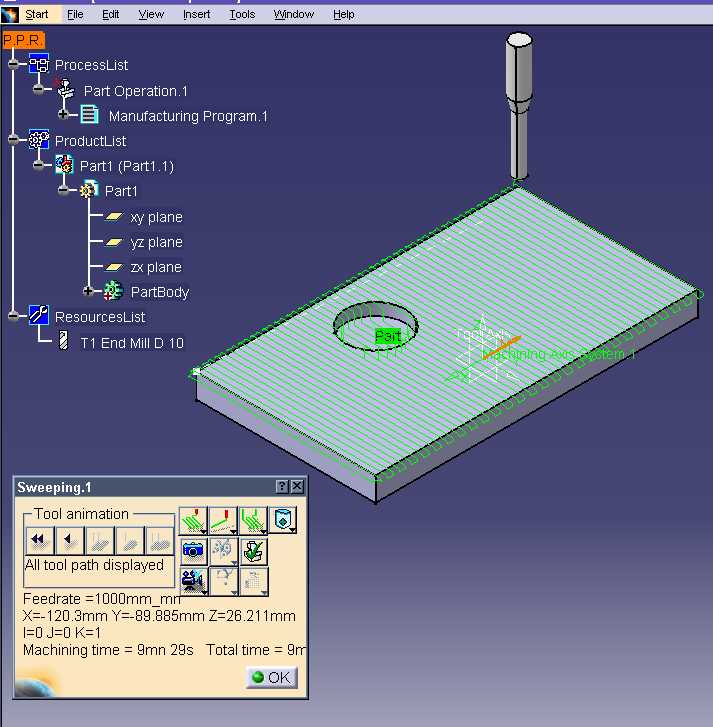
Machining |
NC Review |
Displaying a Distance between Two Points Belonging to the Same Tool PathManipulating a tool path |
| Use Case | ||
AbstractThis article discusses the CAAMfgTPEDisplayDistanceCom use case . |
This use case is intended to help you manipulate the tool path structure. This involves the following:
[Top]
CAAMfgTPEDisplayDistanceCom is a use case of the CAAToolPathEditorItf.edu framework that illustrates ToolPathEditor framework capabilities.
[Top]
CAAMfgTPEDisplayDistanceCom runs with the document CAAMfgToolPath.CATPart shown on Fig.1.
 |
[Top]
To launch CAAMfgTPEDisplayDistanceCom, you will need to:
# Decomment this line in file ToolPathEditor.edu.dico to run CAAMfgTPEAddToolBar Sample # CAAMfgTPEM3xAddin CATISmgProgramAddin libCAAMfgTPEAddToolBar
| Windows | InstallRootDirectory\CAADoc\CAAToolPathEditorItf.edu\CNext\resources\graphic |
| Unix | InstallRootDirectory/CAADoc/CAAToolPathEditorItf.edu/CNext/resources/graphic |
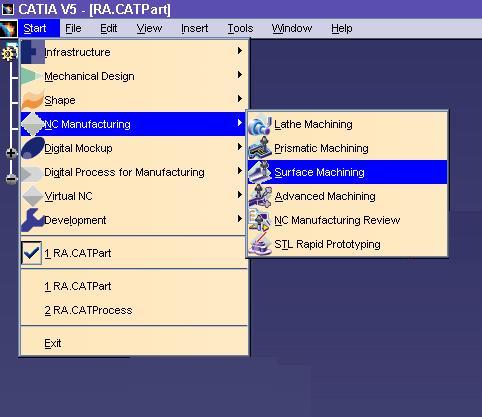
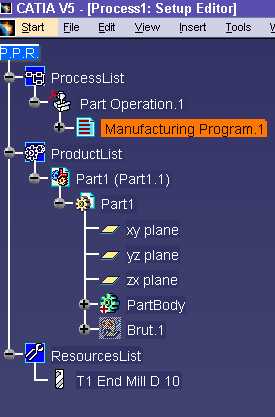
This displays the PPR document:
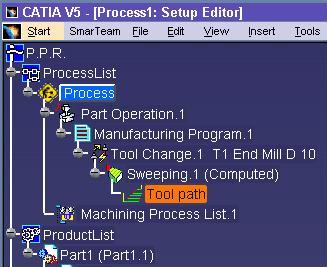
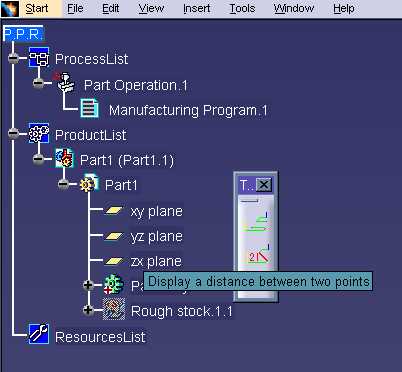
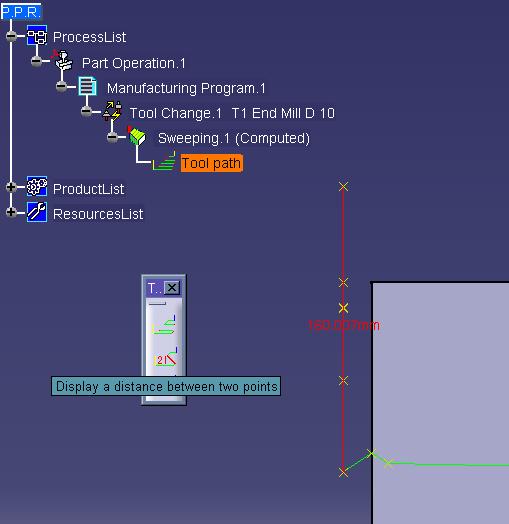
[Top]
The CAAMfgTPEDisplayDistanceCom use case is made of a class named CAAMfgTPEDisplayDistanceCom located in the CAAMfgTPEAddToolBar.m module of the CAAToolPathEditorItf.edu framework:
| Windows | InstallRootDirectory\CAADoc\CAAToolPathEditorItf.edu\CAAMfgTPEAddToolBar.m |
| Unix | InstallRootDirectory/CAADoc/CAAToolPathEditorItf.edu/CAAMfgTPEAddToolBar.m |
where InstallRootDirectory is the directory where the CAA CD-ROM
is installed.
[Top]
There are four logical steps in CAAMfgTPEDisplayDistanceCom:
We now comment each of those sections by looking at the code.
[Top]
The class that will implement the command is named CAAMfgTPEDisplayDistanceCom.
Create the CAAMfgTPEDisplayDistanceCom class header file:
class ExportedByCAAMfgTPEAddToolBar CAAMfgTPEDisplayDistanceCom : public CATStateCommand
{
public:
DeclareResource (CAAMfgTPEDisplayDistanceCom,CATStateCommand)
CAAMfgTPEDisplayDistanceCom (CATString* argument);
virtual ~CAAMfgTPEDisplayDistanceCom();
void BuildGraph();
void Valuate (const CATBaseUnknown_var& iValue);
private:
// to Create the rep of the tool path
void CreateController();
// Delete the rep of the tool path
void DeleteController();
// To update the rep of the tool path
void DispatchInfo();
// To get the tool path
boolean GetSelection (void* data);
// To Terminate the command
boolean End (void* data);
// To display the distance between two points.
void DisplayDistance();
// To create the selector of points
void SetSelector();
// Processing of events.
void PreActivate (CATCommand*, CATNotification*, CATCommandClientData);
void Move (CATCommand*, CATNotification*, CATCommandClientData);
void EndPreActivate (CATCommand*, CATNotification*, CATCommandClientData);
// To process the selection of a point.
void ActivateSelector (CATCommand*, CATNotification*, CATCommandClientData);
// To remove the rep of the distance.
void RemoveDistanceRep();
// To remove the rep of the point.
void RemovePointRep();
// To convert a length in the current unit.
void ConvertLengthInUnit(double iLength, CATUnicodeString& ioLengthinUnit);
CATIMfgToolPath_var _ToolPath;
CAT3DViewer* _Viewer;
CATPathElementAgent* _TPSelectionAgent;
CATDialogAgent* _TPEndAgent ;
CAT3DCustomRep* _DistanceRep;
CATMathPoint _FirstPoint, _SecondPoint;
CATPathElement* _ToolPahVisu;
IID* _iid;
CATVisManager* _VisuManager;
CAT3DPointRep* _CurrentPointRep;
CATSelector* _Selector;
double _Distance;
boolean _hasFirstPoint, _hasSecondPoint;
};
|
The CAAMfgTPEDisplayDistanceCom class C++-derives from CATStateCommand. The DeclareResource macro declares that the resource file is CAAMfgTPEDisplayDistanceCom.CATNls. The class has a constructor, a destructor, a DisplayDistance method to compute the distance, severals methods to manage the user's interaction and the rep of the tool path, and a copy constructor.
[Top]
First you have to implement the method BuilGraph, which will provide you with capturing the user's interactions.
void CAAMfgTPEDisplayDistanceCom::BuildGraph()
{
// To Select tool path.
_TPSelectionAgent = new CATPathElementAgent("ToolPathSelection");
if (NULL != _TPSelectionAgent) {
_TPSelectionAgent->SetOrderedElementType(CATIMfgCompoundTraject::ClassName());
_TPSelectionAgent->SetBehavior(CATDlgEngWithPrevaluation|CATDlgEngWithCSO|CATDlgEngMultiAcquisition);
AddCSOClient(_TPSelectionAgent);
}
// To terminate the command
if ( _TPEndAgent == NULL ) {
_TPEndAgent = new CATDialogAgent("End");
if (NULL != _TPEndAgent)
_TPEndAgent->AcceptOnNotify(NULL, CATEdit::ClassName());
}
CATDialogState* firstState = GetInitialState("TPESelectToolPath");
if (NULL != firstState) firstState->AddDialogAgent(_TPSelectionAgent);
CATDialogState* secondState = AddDialogState("TPEEndCommand");
if (NULL != secondState)
secondState->AddDialogAgent(_TPEndAgent);
CATDialogTransition * firstTransition =
AddTransition (firstState, secondState,
IsOutputSetCondition(_TPSelectionAgent),
Action((ActionMethod) &CAAMfgTPEDisplayDistanceCom::GetSelection));
AddTransition (secondState, NULL,
IsOutputSetCondition(_TPEndAgent),
Action((ActionMethod) &CAAMfgTPEDisplayDistanceCom::End));
}
|
Now the method GetSelection is implemented. It gets the selected tool path.
boolean CAAMfgTPEDisplayDistanceCom::GetSelection (void* data)
{
CATBoolean RESULT = CATFalse;
CATSO* selectedObjects = NULL;
if (NULL != _TPSelectionAgent)
selectedObjects = _TPSelectionAgent->GetListOfValues();
// We display only one tool path in this command
if ( selectedObjects ) {
if ( selectedObjects->GetSize() == 1 ) {
CATPathElement* pathElement=NULL;
CATIMfgCompoundTraject* ptrCTraject=NULL;
CATIMfgCompoundTraject_var itfCmpTraject;
pathElement = (CATPathElement*) (*selectedObjects)[0];
if (NULL != pathElement) {
// A CATIMfgCOmpoundTraject must have been seletecd
ptrCTraject = (CATIMfgCompoundTraject *) (pathElement->FindElement(CATIMfgCompoundTraject::ClassId()));
itfCmpTraject = ptrCTraject;
if (!! itfCmpTraject ) {
_ToolPath = itfCmpTraject;
ptrCTraject->Release();
ptrCTraject=NULL;
RESULT = CATTrue;
}
pathElement=NULL;
}
// Display the tool path.
CreateController();
DispatchInfo();
// To Select points.
SetSelector();
}
}
return RESULT;
}
|
First, we verify that the selected object is a tool path object, then we display it ( call to methods CreateController to create the image then a call to method DispatchInfo to display it in the 3d viewer). Then we create a selector to select points on a tool path.
void CAAMfgTPEDisplayDistanceCom::SetSelector()
{
// To get the rep of the points
CATRep* pointsRep=NULL;
CATIMfg3DToolPathVisuData_var VisuData (_ToolPath);
if (!! VisuData)
VisuData->GetPointsRep(&pointsRep);
if ( _Selector == NULL ) {
_Selector = new CATSelector (this,"ToolPathSelector", pointsRep);
AddAnalyseNotificationCB ( _Selector,
_Selector->GetCATPreactivate(),
(CATCommandMethod)&CAAMfgTPEDisplayDistanceCom::PreActivate,NULL);
AddAnalyseNotificationCB ( _Selector,
_Selector->GetCATActivate(),
(CATCommandMethod)&CAAMfgTPEDisplayDistanceCom::ActivateSelector,NULL);
AddAnalyseNotificationCB ( _Selector,
_Selector->GetCATMove(),
(CATCommandMethod)&CAAMfgTPEDisplayDistanceCom::Move,NULL);
AddAnalyseNotificationCB ( _Selector,
_Selector->GetCATEndPreactivate(),
(CATCommandMethod)&CAAMfgTPEDisplayDistanceCom::EndPreActivate,NULL);
}
else {
_Selector->AssociateToRep(pointsRep);
}
}
|
[Top]
The method Activateselector is called when an end-user click on a point of the tool path.
void CAAMfgTPEDisplayDistanceCom::ActivateSelector(CATCommand* c1, CATNotification* c2, CATCommandClientData c3)
{
CATGraphicElementIntersection* Intersection = NULL;
if (NULL != _Selector) {
Intersection = (CATGraphicElementIntersection*)
_Selector->SendCommandSpecificObject (CATGraphicElementIntersection::ClassName(), c2);
}
if (!Intersection) return;
if ( _hasFirstPoint) {
_hasSecondPoint = CATTrue;
_SecondPoint = Intersection->point;
_Distance = _FirstPoint.DistanceTo(_SecondPoint);
DisplayDistance ();
_hasFirstPoint = CATFalse;
}
else {
_hasFirstPoint = CATTrue;
_FirstPoint = Intersection->point;
_Distance = _FirstPoint.DistanceTo(_SecondPoint);
if ( _hasSecondPoint) {
DisplayDistance ();
_hasSecondPoint = CATFalse;
}
}
Intersection->Release();
if ( _Viewer) _Viewer->Draw();
}
|
[Top]
The next is to compute distance between two selected points and to display this information in the 3d viewer.
void CAAMfgTPEDisplayDistanceCom::DisplayDistance()
{
if ( _hasFirstPoint && _hasSecondPoint ) {
RemoveDistanceRep();
CATUnicodeString distanceStr;
ConvertLengthInUnit(_Distance, distanceStr);
float tab[3] = {(float)_SecondPoint.GetX(),(float)_SecondPoint.GetY(),(float)_SecondPoint.GetZ()};
CAT3DMarkerGP* arrowGP = new CAT3DMarkerGP(tab,1,FILLED_ARROW);
CATMathPointf anchor=(_FirstPoint+ _SecondPoint)/2.0;
CAT3DAnnotationTextGP* textGP = new CAT3DAnnotationTextGP(anchor,distanceStr,BASE_CENTER);
float Points[6] = { (float)_FirstPoint.GetX(), (float)_FirstPoint.GetY(), (float)_FirstPoint.GetZ(),
(float)_SecondPoint.GetX(), (float)_SecondPoint.GetY(),(float)_SecondPoint.GetZ()};
CAT3DLineGP* lineGP = new CAT3DLineGP (Points);
CATGraphicAttributeSet AttributsDir;
AttributsDir.SetColor(RED);
_DistanceRep = new CAT3DCustomRep(lineGP,AttributsDir);
if (NULL != _DistanceRep) {
_DistanceRep -> AddGP(textGP,AttributsDir);
_DistanceRep -> AddGP(arrowGP,AttributsDir);
}
if (_Viewer) {
_Viewer->AddRep(_DistanceRep);
_Viewer->Draw();
}
}
}
|
[Top]
This article provides an example on how to use the structure of the tool path and how to make command in the tool path editor. It shows how to select points a on a tool path.
[Top]
| [1] | Building and Launching a CAA V5 Use Case |
| [2] | Dump of Tool Path Content Command |
| [Top] | |
| Version: 1 [March 2002] | Document created |
| [Top] | |
Copyright © 2002, Dassault Systèmes. All rights reserved.